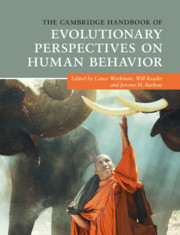Book contents
- The Cambridge Handbook of Evolutionary Perspectives on Human Behavior
- The Cambridge Handbook of Evolutionary Perspectives on Human Behavior
- Copyright page
- Dedication
- Contents
- Figures
- Tables
- Contributors
- Preface
- Acknowledgments
- Part I The Comparative Approach
- Part II Sociocultural Anthropology and Evolution
- Part III Evolution and Neuroscience
- 7 Are Evolutionary Psychology and the Neuroscience of Motivation Compatible?
- 8 Are We Designed to Be Happy?
- 9 Environmental Pressures on Transgenerational Epigenetic Inheritance
- Part IV Group Living
- Part V Evolution and Cognition
- Part VI Evolution and Development
- Part VII Sexual Selection and Human Sex Differences
- Part VIII Abnormal Behavior and Evolutionary Psychopathology
- Part IX Applying Evolutionary Principles
- Part X Evolution and the Media
- Index
- References
7 - Are Evolutionary Psychology and the Neuroscience of Motivation Compatible?
from Part III - Evolution and Neuroscience
Published online by Cambridge University Press: 02 March 2020
- The Cambridge Handbook of Evolutionary Perspectives on Human Behavior
- The Cambridge Handbook of Evolutionary Perspectives on Human Behavior
- Copyright page
- Dedication
- Contents
- Figures
- Tables
- Contributors
- Preface
- Acknowledgments
- Part I The Comparative Approach
- Part II Sociocultural Anthropology and Evolution
- Part III Evolution and Neuroscience
- 7 Are Evolutionary Psychology and the Neuroscience of Motivation Compatible?
- 8 Are We Designed to Be Happy?
- 9 Environmental Pressures on Transgenerational Epigenetic Inheritance
- Part IV Group Living
- Part V Evolution and Cognition
- Part VI Evolution and Development
- Part VII Sexual Selection and Human Sex Differences
- Part VIII Abnormal Behavior and Evolutionary Psychopathology
- Part IX Applying Evolutionary Principles
- Part X Evolution and the Media
- Index
- References
Summary
In evolutionary psychology (EP), motivation is the poor relation, not even earning an index entry in some of the principal textbooks (Buss, 2016; Campbell, 2013; Ray, 2013). By contrast, emotion sometimes justifies a full chapter (Ray, 2013). Of course, some phenomena linked to motivation, such as attachment and, in particular, sexual behavior, are very well described in the EP literature.
Motivational processes are the class that is responsible for selecting a course of action, organizing goal-directed behavior, and energizing behavior to meet the goal (Toates, 1986). Goals are selected on the basis of a combination of internal states and salient features of the environment and are pursued until the associated motivation is lowered to zero or a higher-order priority emerges. Motivational processes are responsible for resolving competition and conflict between several potential goals that might simultaneously exist.
- Type
- Chapter
- Information
- Publisher: Cambridge University PressPrint publication year: 2020
References
- 1
- Cited by



